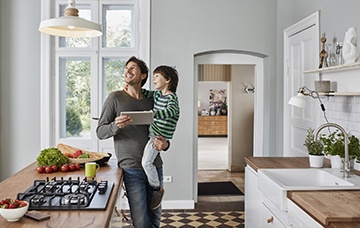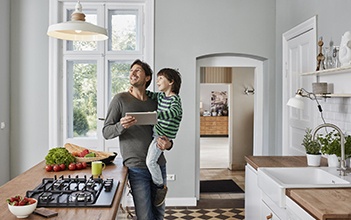How a sustainable home can help lower your energy bills
Having a sustainable home can help you lower your home energy use, read on to find out more.




With the ongoing climate crisis, we’re all aware that we need to take action for climate and save energy at home to help lower our bills.
Here, we share our top ways to help you lower your energy use this winter, whilst also being more sustainable at home.
Make your home as energy efficient as possible
An inefficient home doesn’t just mean you’re spending more on your energy bills, it also means your home isn’t as sustainable as it could be. But there are some simple ways you can improve your home’s energy efficiency.
If your home isn’t fully insulated, you could be wasting energy and money heating your home only for that heat to escape through poor insulation. Having the right level of insulation throughout your home means the heat will stay inside for longer, so less work for your boiler or heat pump and a warmer, cosier home for you and your family. Consider your walls, roof and floor when looking at insulating your home as heat can escape through all of these areas.
Draughts from around windows and doors are telltale signs of where the cold air comes in and heat goes out. So draughtproof your home using foam, or a metal or plastic draught excluder - which can easily be purchased from a local DIY shop - around windows, doors and even around places such as loft hatches, keyholes, and letterboxes to help keep the cold air out and your warm air in.
Check your boiler is running efficiently
Almost 80% of UK homes are heated using gas central heating1 so it’s important to make sure that your boiler is working at its best. This not only helps reduce carbon emissions, but also ensures your home stays warm and safe this winter.
One of the easiest ways to maintain the efficiency and safety of your boiler, is to get it serviced at least once a year. Rather than waiting for something to go wrong, servicing your boiler regularly can help you identify any issues early and prevent costly repairs down the road. A typical boiler service can cost between £60-£100, but check your boiler cover (if you have it), as some companies include an annual service as part of your boiler cover.


And if you have a condensing combi boiler, check the flow temperature. The boiler flow temperature is the temperature your boiler heats the water to before it’s sent to the radiators around your home. The flow temperature is different to the thermostat temperature and it’s often something people don't think about. By simply checking and reducing the flow temperature, you could help to reduce your gas bills, saving up to £112 a year2 and lowering your carbon emissions, without impacting the warmth of your home.
Monitor your energy use and reduce waste
Knowing when and where you use your energy can be a great way to make easy changes to ensure you use less and to keep energy costs as low as possible. Installing a smart meter and using your smart in-home display to track your energy use around the home can help you save energy and money. That’s because you’ll easily be able to see where you use the most energy and how you could be more energy efficient.
When heating your home, it can be easy to waste energy by setting your thermostat too high or by heating rooms you’re not using. Ideally your home thermostat should be set to between 18oC and 21oC, however if you have rooms in your house that aren’t often used, make sure you set the temperature lower in these rooms. You should keep radiators on at least the minimum setting to ensure your system runs properly and rooms don’t get damp.
Smart thermostats, such as Bosch EasyControl allow you to control your heating in each room separately and remotely from your smartphone, giving you easier control over your home heating.


Check out additional support available to you this winter
Whilst there are some low cost and easy ways to become more energy efficient at home, there are also other ways that require more investment, such as installing solar panels, upgrading your boiler to a more energy efficient one or installing an air source heat pump as an alternative way to heat your home.
There is a range of additional support and grants available to help with improving the energy efficiency of your home, particularly if you’re elderly or on a low income and claiming certain benefits. We can help you understand what you’re eligible for with our grant finder where you can find out what schemes you qualify for.
Some of the schemes available include:
The Great British Insulation Scheme
You could be eligible for free or part-funded cavity wall insulation as part of our support for the Great British insulation scheme. By filling your cavity walls with insulation, each year you could save around £300 on your heating bills3 and 650kg of CO2 as well3.
The ECO4 energy efficiency scheme
As part of the ECO4 energy efficiency scheme, if you’re eligible and are living in a home with a low EPC rating, you’ll be offered a bespoke package of improvements to help you increase the efficiency of your home and reduce your energy costs.
Working with you, your landlord or your housing provider, we’ll carry out a tailored survey of your property and what we offer will depend on the results of your survey, but it could include measures such as installing an air source heat pump, insulation or a smart thermostat.
Social Housing Decarbonisation Fund
Through the Government's Social Housing Decarbonisation Fund (SHDF), energy companies like E.ON are working with Social Housing providers across the country to deliver home energy efficiency upgrades, such as insulation, solar panels and PVC windows and doors, to homes with low energy efficiency ratings.
In addition to improving your home’s energy efficiency, it’s also worth checking whether you could get help with energy costs, with different schemes funded by suppliers like E.ON Next and by the Government.
Read our other blogs


Creating a sustainable home can sound like a tall order. So we’re sharing seven ways you can make your home more sustainable.


Chris Lovatt, Chief Operating Officer of E.ON UK Solutions, shares some of the ways in which E.ON is helping customers improve the sustainability of their homes.


Looking for a new home can be a long and stressful process but knowing what to look for can help make the journey easier.
1. Statista: Most used heating methods in the United Kingdom 2022
2. Nesta commissioned the Salford Energy House to test how gas consumption for heating varies at flow temperatures of 80°C, 70°C, 60°C, 55°C and 50°C. The tests were carried out between August and September 2022. The Salford Energy House is a traditionally built, two-bedroom terraced house with solid brick walls, suspended timber floors and single-glazed windows with a conventional “wet” central heating system fired by a gas boiler. It has an energy efficiency rating of E, a relatively low rating. The Energy House is built within an environmental chamber that can simulate different temperatures and weather conditions. The tests were conducted with outdoor temperatures of 4.5°C, to simulate average UK winter temperatures. Most condensing boilers in use across the UK are set with flow temperatures of 70-80°C, with CAR estimating that 90% of combination boilers are set to 75°C or similar. The Salford Energy House evidence suggests that homes that currently have their boiler flow temperatures set to 80°C could reduce gas consumption for space heating by 12% by setting their flow temperature to 60°C, or by 16% by turning down to 55°C. Assuming that homes use approximately 75% of their gas on space heating, this means that these reductions in gas demand would result in overall gas consumption savings of 9% (for those turning down to 60°C) or 12% (for those turning down to 55°C). Based on the 9% saving on total gas use from reducing flow temperatures from 80°C to 60°C (reported above), we estimate that a medium-sized household with an annual gas consumption of 12,000 kWh would save 1,092 kWh of gas per year. At a price of 10.3p per kWh of gas (the Energy Price Guarantee unit rate for gas), this equates to £112 per year. https://www.nesta.org.uk/project-updates/boiler-settings-ideas-to-encourage-action/
3. Energy Saving Trust: cavity wall insulation. Energy and CO2 savings based on a semi-detached house. Average savings correct as of September 2023.